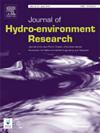Investigation on the lateral anti-seepage capacity of a vertical soil sand layer (VSSL) in a sunken lawn
Abstract
The use of a sunken lawn is an emerging Low Impact Development (LID) technique to effectively control storm runoffs. However, the random infiltration of rainwater that occurs due to the construction of a sunken lawn in an area of collapsible loess seriously threatens the safety of buildings around it. Setting up a vertical soil sand layer (VSSL) structure next to a sunken lawn as an anti-permeate method has been proposed in this study. To analyze the lateral anti-seepage effects of a VSSL, a sunken lawn model around a building was established based on soil physical parameters, and water seepage in the sunken lawn was investigated using a infiltration experiment and HYDRUS-2D software. The results show that the anti-seepage effects of a VSSL can significantly reduce the average wetting front migration length and water content at the observation points behind the sand layer. The Nash-Sutcliff Efficiency (NSE) index was used to evaluate the accuracy and reliability of the HYDRUS-2D model. The values of the NSE index obtained were greater than 0.82 (varied between 0.82 and 0.98) which confirmed the applicability of the HYDRUS-2D software in accurately describing the hydraulic behavior of the lateral anti-seepage effects of the VSSL in a sunken lawn. Simulation infiltration tests showed that, on the side of the VSSL, the wetting front migration length was reduced by 55.5% on average, and the water content of the observation points behind the sand layer was reduced by 40.5%, increasing the stability of the loess around the building infrastructure. The results are of value in practical applications, such as for devising engineering or non-engineering measures to avoid loess collapsibility around sunken lawns.


 求助内容:
求助内容: 应助结果提醒方式:
应助结果提醒方式:


